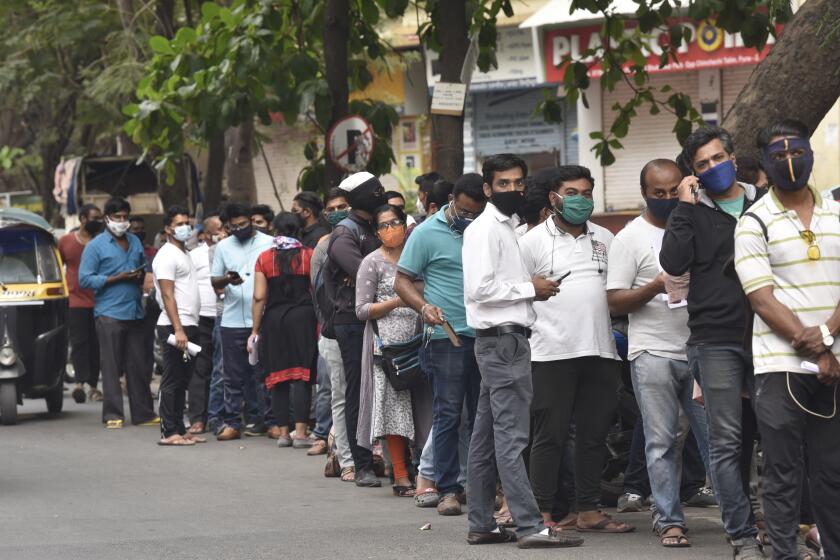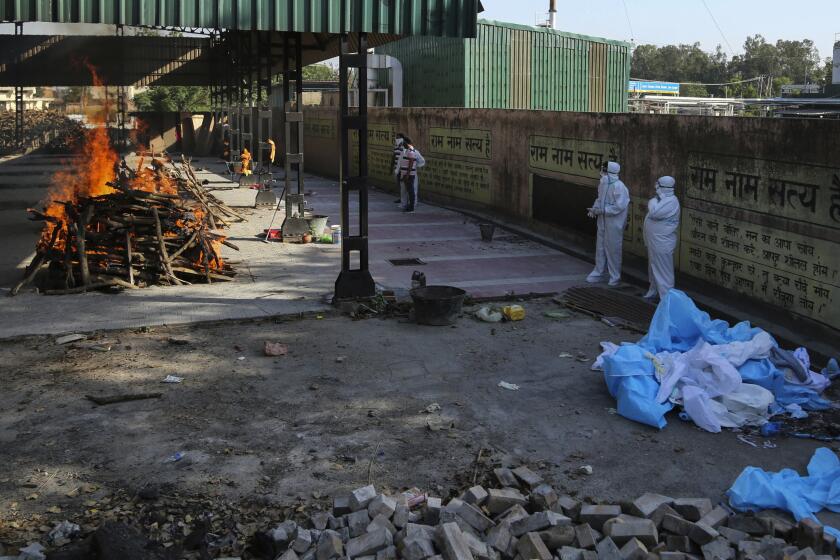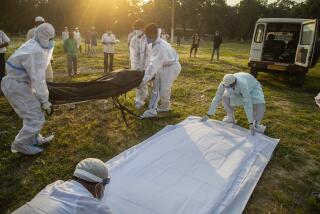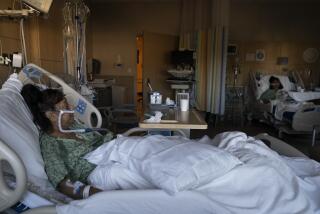Begging for air: India’s oxygen crisis imperils its COVID-19 response
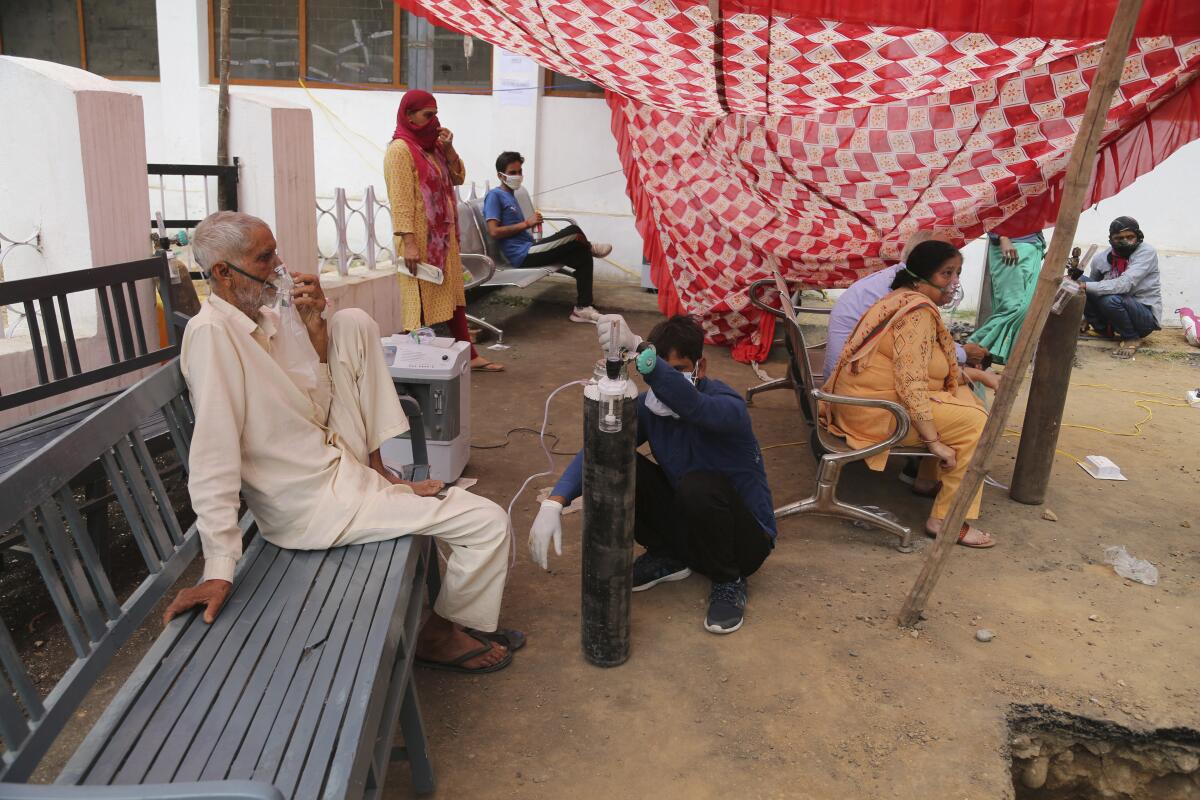
- Share via
MEERUT, India — The men stood shoulder to shoulder in the blazing heat, their chests leaning against empty oxygen cylinders lodged in the dirt.
They had come from all over to this makeshift center for refilling oxygen tanks in a city 40 miles northeast of the Indian capital of New Delhi, in a desperate bid to score what has become the most precious commodity in this pandemic-stricken nation.
Police and government officials guarded what little supply was available. They demanded to see medical records to ensure oxygen wouldn’t be siphoned to the black market. One man who didn’t have the proper paperwork held up a video showing his 6-year-old daughter struggling to breathe.
“How am I supposed to show and prove that my daughter is dying?” he said. “There are no beds available at the government hospital.”
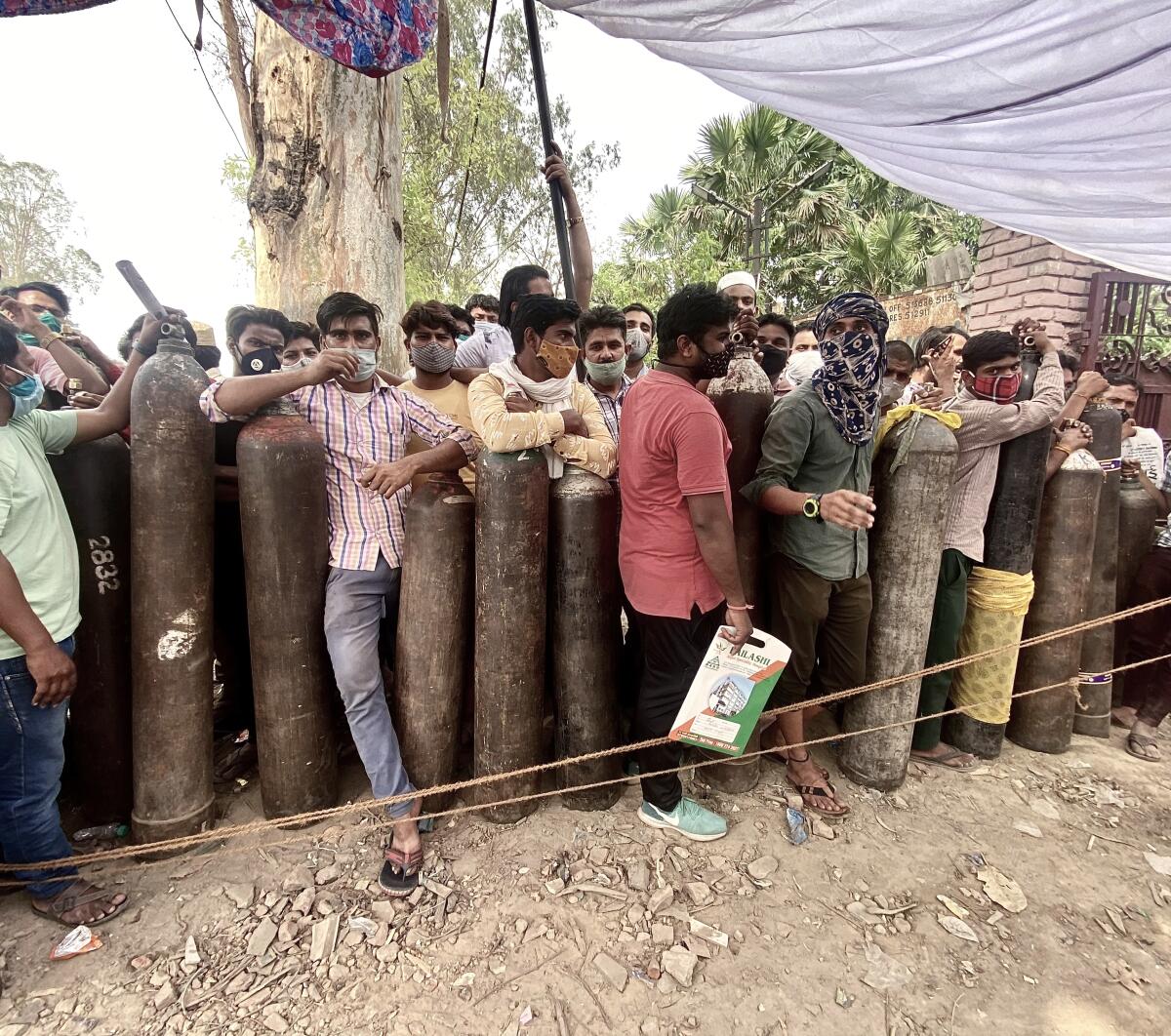
A 25-year-old man who gave only his first name, Arif, pleaded with a police officer for help.
“I beg you. Please give me one cylinder of oxygen,” he said. “If I don’t get one, my mother will die.”
The policeman apologized and said there was nothing he could do. Arif collapsed to the ground and sobbed.
“COVID isn’t killing us,” yelled another man in line. “The lack of oxygen is killing us.”
The situation in Meerut is a snapshot of the despair spiraling across India as demand for oxygen far outpaces availability, in a nation where hundreds of thousands each day are becoming infected with COVID-19. The crisis is reminiscent of the shortages of masks, sanitizer and gloves earlier in the pandemic, though with consequences that are far more devastating.
Patients are suffocating to death in hospitals with empty tanks. Many are paying the equivalent of several months’ salary to buy oxygen cylinders on the black market. Gangs are hoarding cylinders and devices called “concentrators” that can draw medical oxygen from the air. Meanwhile, social media are flooded with hashtags such as #SOSoxygen, #OxygenCrisis and #OxygenShortage.
“Oxygen cylinder required in Deoria. Patient name — Vedvyash Saini. Age — 45. Oxygen level — 80%,” read a typical tweet. A blood oxygen level of 95% or above is normal for most adults.
The clamor for something so elemental to life has eclipsed India’s vaccination drive and brought widespread criticism of its leaders, some of whom declared the virus defeated months ago, despite warnings of highly contagious variants. India’s crisis foreshadows what may unfold with neighboring countries, such as Nepal, whose overburdened medical systems are also facing steep rises in case numbers.
High-rise apartment towers are hotbeds of infections, whereas some slums are proving resilient after enduring the first wave of the virus last year.
Lack of preparation for the March surge meant that India did not increase its production of oxygen, in a country that already lacked an adequate supply. Prime Minister Narendra Modi has at times appeared more interested in silencing critics of the COVID-19 response and threatening hospital workers who report oxygen shortages than in confronting the breadth of a disaster that has infected more than 24 million people.
The death toll in parts of India is rising faster than bodies can be cremated, leading to scores found floating in the Ganges River.
The national response has been in disarray as Modi has been mostly absent during the crisis and the central government has largely delegated policy and procurement of medical supplies to the states.
“India’s COVID-19 response has failed because it ignored a fundamental first principle of good governance — the principle of subsidiarity, which means that the central authority performs only those functions that cannot be performed at the local level and no other,” Yamini Aiyar, president and chief executive of the New Delhi-based Center for Policy Research, wrote in an editorial published Sunday in the Hindustan Times. “Rather than a coordinated response, states are at war with the [central government] and each other.”
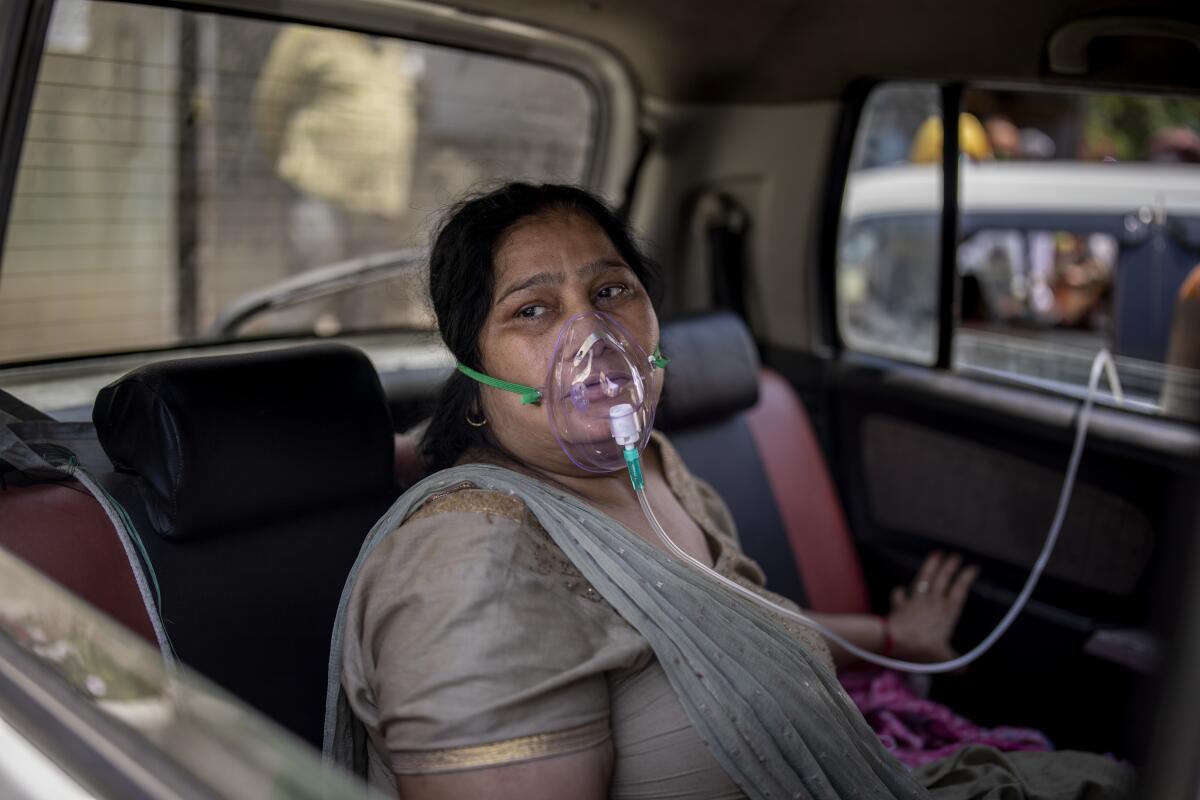
The mishandling of medical support prompted India’s Supreme Court to announce on Saturday that it would establish a task force to ensure the “effective and transparent” distribution of oxygen.
Modi’s government says the country produces enough oxygen, up to 9,000 tons a day, to meet demand. The problem, it claims, is getting the oxygen to people in need. Many of India’s oxygen plants are on the coasts, far from the areas hit hardest by the second wave, including New Delhi and Bengaluru, the city of more than 8 million formerly known as Bangalore.
India recently mobilized the military to airlift oxygen supplies and has sent thousands of tons across the country on trains dubbed the “Oxygen Express.” Despite those efforts, oxygen remains scarce — leading to rising tension and growing anger.
In Muzaffarnagar, a city just north of Meerut, more than 200 people lined up recently to request oxygen from a government official. When many learned they would leave empty-handed, they berated the official, who was guarded by police.
“The government has failed and collapsed completely,” said Muzamil Rana, 28, who was denied a cylinder and said he has spent nearly $1,300 — for him, an astronomical sum — on black-market oxygen for a relative. “We can pay money to the government if they can at least provide us oxygen.”
Medical experts warn it will be impossible to distribute enough oxygen if cases keep multiplying. Calls are growing for a national lockdown to break the chain of transmission that has resulted in 262,000 recorded deaths, though the actual number is believed to be significantly higher.
Additionally, doctors are reporting the emergence of a rare fungal disease called mucormycosis in current and former COVID-19 patients with weakened immune systems. The infection, also known as black fungus, attacks the nose, brain and lungs and has required doctors to remove some patients’ eyes.
The country’s second wave is being partly blamed on a coronavirus variant known as B.1.617, first found in India last year, that the World Health Organization has classified as a “variant of global concern” because it has shown signs of being more infectious.
Infections and deaths continue to climb at alarming rates as India’s second COVID-19 wave threatens to topple its healthcare system.
The variant has renewed fears of a major resurgence of the disease just as restrictions have eased in countries with high vaccine rates, including the United States. New outbreaks have swept across Asia, including in Singapore, Taiwan and other countries that had succeeded over the last year in keeping infection rates down.
The crisis in India underscores how ill-equipped poorer countries are at delivering basic medical treatment.
Hospitals in the U.S. often have their own oxygen plants, but medical facilities in impoverished countries rely on the delivery of tanks — a far more costly and inefficient form of distribution. It is common these days in India to see people trying to move unwieldy cylinders weighing more than 100 pounds over unpaved roads. And with all that effort, a single tank may last only a few dozen hours, depending on how badly the virus has affected the patient’s lungs.
The pandemic has fueled an unprecedented worldwide demand for oxygen. In the last four months alone, global oxygen needs have nearly tripled, primarily because of the crisis in India. Shortages have also been reported in Brazil, Iran, Mexico, Argentina, Turkey and the Philippines.
“While no country has ever needed oxygen as much as India does right now, other countries who are far less prepared than India may soon experience similar surges,” said Evan Spark-DePass of PATH, a global nonprofit health organization. “The COVID-19 pandemic is the biggest wake-up call the world has ever faced, revealing decades of inequities regarding access to oxygen.”
Times staff writer Pierson reported from Singapore and special correspondent Khan from Meerut.
More to Read
Sign up for Essential California
The most important California stories and recommendations in your inbox every morning.
You may occasionally receive promotional content from the Los Angeles Times.
